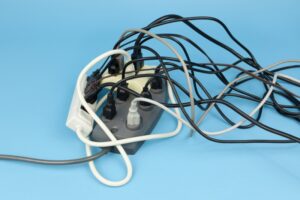Surge protection. What does that mean to you? Don’t worry, there isn’t a wrong answer to this. What you’re thinking of almost certainly counts as surge protection. But that isn’t the whole story.
Okay, did you think of a power strip that you plug into an outlet and which you can then plug various appliances into? That’s what most people think of as home surge protection. These power strips do offer a level of defense against a sudden increase in voltage, since they have a built-in circuit breaker that will trip if too much power runs through it.
We absolutely recommend you use power strips for sensitive equipment like computers, monitors, sound systems, etc. Power strips not only offer protection to the equipment, they allow you to safely plug in a lot more devices into a wall socket.
However, there’s more to surge protection, and we want to talk more about it as well as why we recommend installing a whole-house surge protector in Ellensburg, WA.
The Big Surges
Voltage spikes in a house can occur for a variety of reasons. One of the most common is when a powerful appliance in the house (such as an air conditioner) turns on. This is the type of surge that power strips are the most helpful at dealing with. But power surges come in much stronger varieties, such as those caused by lightning strikes, downed power lines, and malfunctions at a power station.
These big voltage surges can cause enormous damage to your electrical system—and it goes beyond damage to appliances like computers. These surges can wreck lights, destroy outlets and lightswitches, and damage wiring. There’s nothing a power strip can do against that!
The Regular Surges
On the other end of the scale of power surges are the ones you might not notice. These small voltage spikes can occur regularly, often causing the lights in your home to flicker. This might not seem like it’s a problem, but surges like this accumulate over time and damage appliances, shortening their service lives.
The Whole-House Surge Protection
We’ve already recommended a whole-house surge protector, but we need to explain what sets this apart from using a power strip.
A whole-house surge protector isn’t a circuit breaker that cuts off the flow of electricity in case of a voltage spike. You already have a device to do that: the circuit breaker panel. A whole-house surge protector is integrated into the home’s electrical panel to channel excess power into the ground. Electricity always seeks the fastest route to the ground, and a whole-house surge protector offers an excess of electrical current an easy path—which keeps it from tearing into the rest of the electrical system.
A surge protector like this can handle the biggest of voltage spikes from storms and other accidents, ensuring it doesn’t even get into the wiring for your house to do damage. This type of surge protector also regulates electrical flow so smaller incessant surges aren’t wearing away at your valuable equipment.
You’ll need professional electricians to install a whole-house surge protector, and our experts are ready to help.

